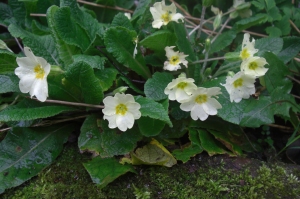
Walk by a bed of these briefly flowering native Primulas and the air is filled with the sweetest fragrance reminiscent of confectionery. Before over picking there were carpets of these on woodland floors, taking the opportunity of no leaf canopy to flower and pollinate in the warming spring sun. They easily set seed and spread with plantlets. They have a panacea of herbal properties and the leaves and flowers are edible. As with all plants allergies and misidentification can lead to serious ill health. Further interesting facts can be found here. http://wightdruids.com/index.php?option=com_content&view=article&id=109&Itemid=126

The lesser periwinkle, flowers prolifically along our hedgerows now and throughout the year. It’s blue violet flowers last for ages and it can be left to it’s own devices, for more on periwinkle go to our plant index.
Forsythia, is always first to put on a show in the spring garden
Don’t forget to prune after flowering as it flowers on last year’s growth. Bring in a few branches in a vase to light up the room.




 Use a very soft brush or downy feather, it will improve cropping. I also do it with my peaches in the poly-tunnel, although leaving the doors open this time of year (if temp is not freezing) can help. My favourite flowering tree of all is this magical Umeboshi plum Prunus Ume.
Use a very soft brush or downy feather, it will improve cropping. I also do it with my peaches in the poly-tunnel, although leaving the doors open this time of year (if temp is not freezing) can help. My favourite flowering tree of all is this magical Umeboshi plum Prunus Ume.


